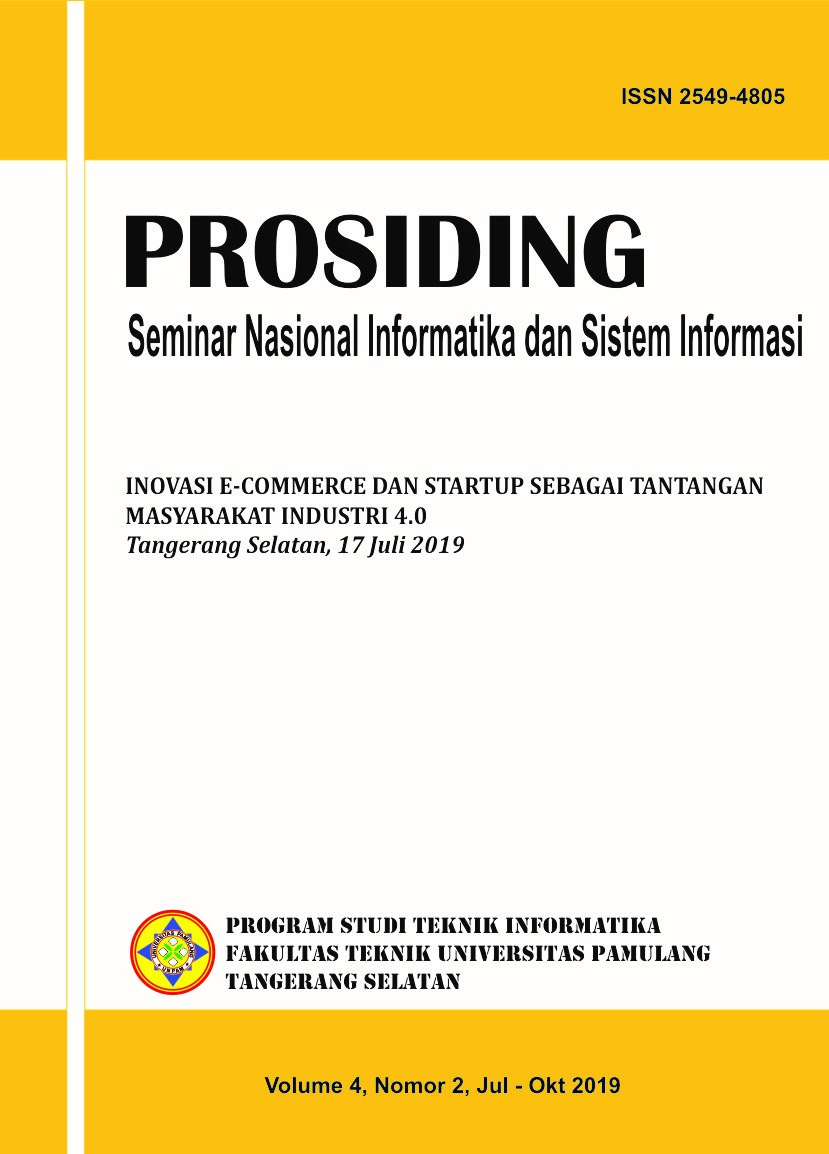Analisa dan Perancangan Sistem Teknologi Augmented Reality pada Matakuliah Pengantar Teknologi Informasi di Universitas Pamulang
Keywords:
Augmented Reality, SDLC, Rancang BangunAbstract
Augmented Reality (AR) adalah sebuah teknologi dimana memasukkan dan memberikan input berupa objek virtual 3D kedalam lingkungan yang real-time. Penerapan augmented reality ini akan diimplemantasikan kedalam pembelajaran khususnya matakuliah PTI atau dikenal pengantar teknologi informasi, dimana matakuliah ini adalah matakuliah yang banyak menyinggung visual serta beberapa bentuk dari sebuah teknologi - teknologi yang berkembang sekarang ini, penyampaian gambar dan bentuk kondisi dari sebuah teknologi haruslah jelas dan tidak berupa hanya sekedar gambar, dimana hal tersebut dapat memberikan pemahaman bagi mahasiswa dalam memahami teknologi informasi sekarang ini. Dalam pembuatan rancang bangun dan penerapan teknologi augmented reality ini menggunakan model SDLC waterfall, dimana memiliki tahapan yang bertahap dan tahapannya mudah dipahami, dikarnakan memberikan modul bertahap dan dimulai dari analisa sampai dengan pengujian dan maintenance. Penerapan augmented reality ini diimplementasikan ke platform mobile android, dimana smartphone android ini adalah handphone yang menjadi kebutuhan masyarakat dalam mencari sebuah informasi terutama pada ruang lingkup pendidikan. Penelitian ini diharapkan dapat memberikan inovasi baru dan pengembangan khususnya pada matakuliah pembelajaran pengantar aplikasi komputer pada universitas pamulang. Dalam pengembangannya menggunakan metode rancang bangun menggunakan model SDLC waterfall, Pemahaman daya tarik matakuliah, dimana software nantinya akan memberikan sebuah inovasi baru dalam pembelajaran terutama pada matakuliah pengantar teknologi informasi, yang akan digunakan dan diuji langsung oleh mahasiswa universitas pamulang pada semester satuReferences
R. Yazdanifard and O. Jin, “The review of the effectivity of the augmented [1] R. Yazdanifard and O. Jin, “The review of the effectivity of the augmented reality experiential marketing tool in customer engagement,†Glob. J. Manag. Bus. Res., vol. 15, no. 8, p. 7, 2015.
A. H. Safar, A. A. Al-Jafar, and Z. H. Al-Yousefi, “The effectiveness of using augmented reality apps in teaching the english alphabet to kindergarten children: A case study in the state of Kuwait,†Eurasia J. Math. Sci. Technol. Educ., vol. 13, no. 2, pp. 417–440, 2017.
E. Supratman et al., “Pengembangan Media Pembelajaran E-Learning Berbasis Schoology,†vol. 03, no. 03, pp. 310–315, 2018.
D. V. Chulkov, “On the Role of Switching Costs and Decision Reversibility in Information Technology Adoption and Investment,†J. Inf. Syst. Technol. Manag., vol. 14, no. 3, pp. 309–321, 2018.
R. Scroggins, “SDLC and Development Methodologies,†vol. 14, no. 7, pp. 0–2, 2014.
S. Holla and M. M. Katti, “ANDROID BASED MOBILE APPLICATION,†vol. 3, pp. 486–490, 2012.
D. Leo, S. Duha, S. Sarkum, I. Rasyid, and M. Iwan, “Aplikasi Berita Online Berbasis Android : Studi pada Pemerintah Kabupaten Labuhanbatu,†vol. 03, no. 03, pp. 380– 386, 2018.
K. S. Bhakti, “SISTEM INFORMASI INVENTARIS LABORATORIUM BERBASIS WEB Excel , sehingga mempersulit dalam Inventaris Laboratorium pada STIKes Bhakti Mandala Husada Slawi yang,†pp. 7–10.
I. Solikin, J. M. Informatika, F. Vokasi, and U. B. Palembang, “Implementasi Penggunaan Smartphone Android untuk Control PC ( Personal Computer ),†vol. 03, no. 02, pp. 249–252, 2018.
K. Komunikasi et al., “TEKNOLOGI INFORMASI,†vol. 5, no. 1, 2016.
F. Z. Adami and C. Budihartanti, “PENERAPAN TEKNOLOGI AUGMENTED REALITY PADA MEDIA PEMBELAJARAN SISTEM,†no. 8, pp. 122–131.
Y. A. Pramana, K. C. Brata, and A. H. Brata, “Pembangunan Aplikasi Augmented Reality untuk Pengenalan Benda di Museum Berbasis Android ( Studi Kasus : Museum Blambangan Banyuwangi ),†vol. 2, no. 5, pp. 2034–2042, 2018.
M. Permai, “Penerapan teknologi,†pp. 267–274, 2014.
M. G. P, “SOFTWARE DEVELOPMENT LIFECYCLE MODEL ( SDLC ) INCORPORATED WITH RELEASE MANAGEMENT,†pp. 1536–1543, 2016.
K. Anam and A. T. Muharram, “ANALISA DAN PERANCANGAN SISTEM INFORMASI AKADEMIK BERBASIS WEB PADA MI AL-MURSYIDIYYAH AL- ‘ ASYIROTUSSYAFI ’ IYYAH,†vol. 11, no. 2, 2018.
I. E. Sandjaja and D. Purnamasari, “Perancangan Kuisioner Survei Galangan,†vol. 1, no. 1, pp. 27–33, 2017
Downloads
Published
Issue
Section
License
Authors who publish with this journal agree to the following terms:
- Authors retain copyright and grant the journal right of first publication with the work simultaneously licensed under a Creative Commons Attribution License that allows others to share the work with an acknowledgement of the work's authorship and initial publication in this journal.
- Authors are able to enter into separate, additional contractual arrangements for the non-exclusive distribution of the journal's published version of the work (e.g., post it to an institutional repository or publish it in a book), with an acknowledgement of its initial publication in this journal.
- Authors are permitted and encouraged to post their work online (e.g., in institutional repositories or on their website) prior to and during the submission process, as it can lead to productive exchanges, as well as earlier and greater citation of published work (See The Effect of Open Access).
Prosiding Seminar Informatika dan Sistem Informasi have CC-BY-NC-SA or an equivalent license as the optimal license for the publication, distribution, use, and reuse of scholarly work.
In developing strategy and setting priorities, Prosiding Seminar Informatika dan Sistem Informasi recognize that free access is better than priced access, libre access is better than free access, and libre under CC-BY-NC-SA or the equivalent is better than libre under more restrictive open licenses. We should achieve what we can when we can. We should not delay achieving free in order to achieve libre, and we should not stop with free when we can achieve libre.
Prosiding Seminar Informatika dan Sistem Informasi is licensed under a Creative Commons Attribution 4.0 International License
YOU ARE FREE TO:
- Share — copy and redistribute the material in any medium or format
- Adapt — remix, transform, and build upon the material for any purpose, even commercially.
- The licensor cannot revoke these freedoms as long as you follow the license terms

